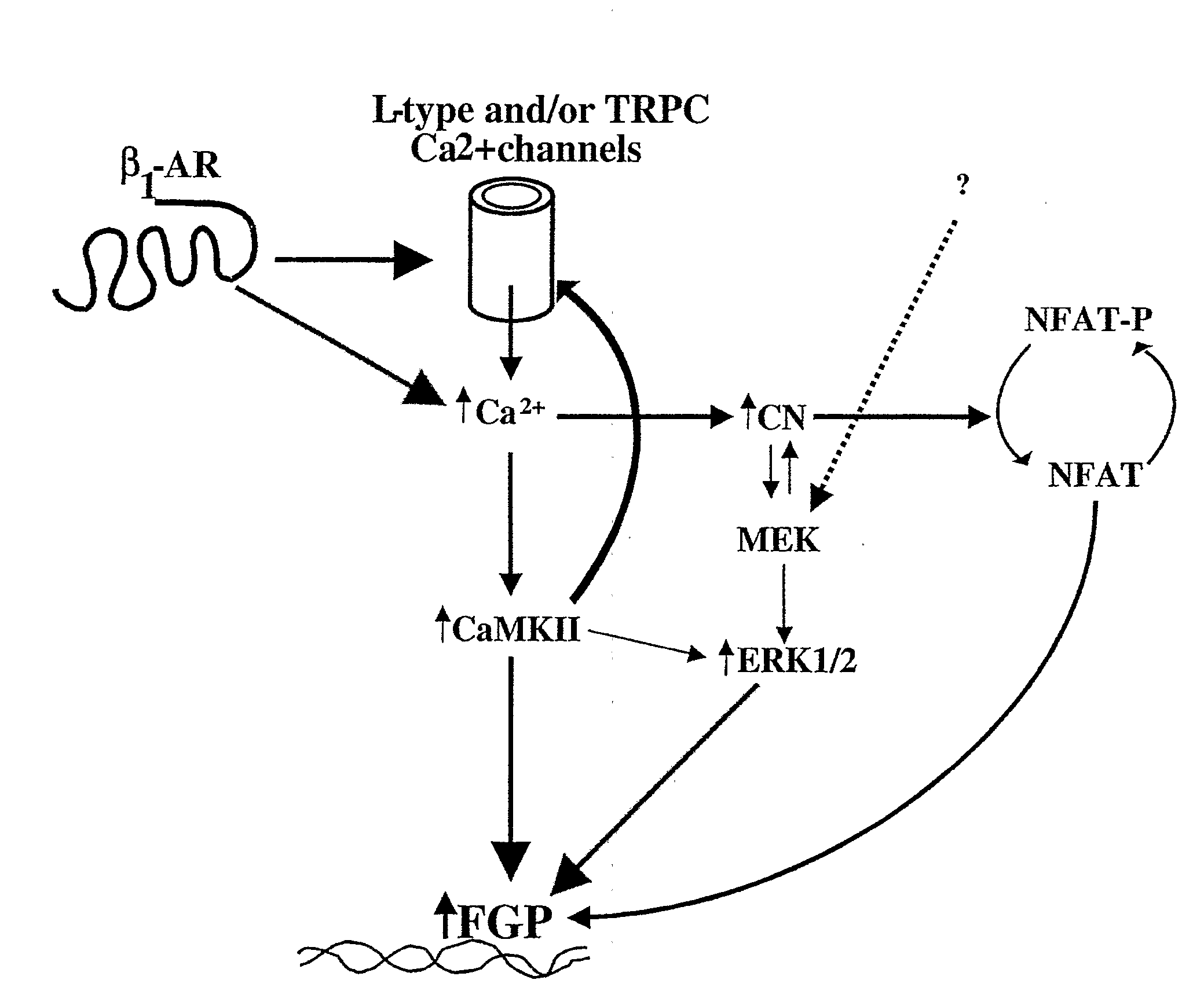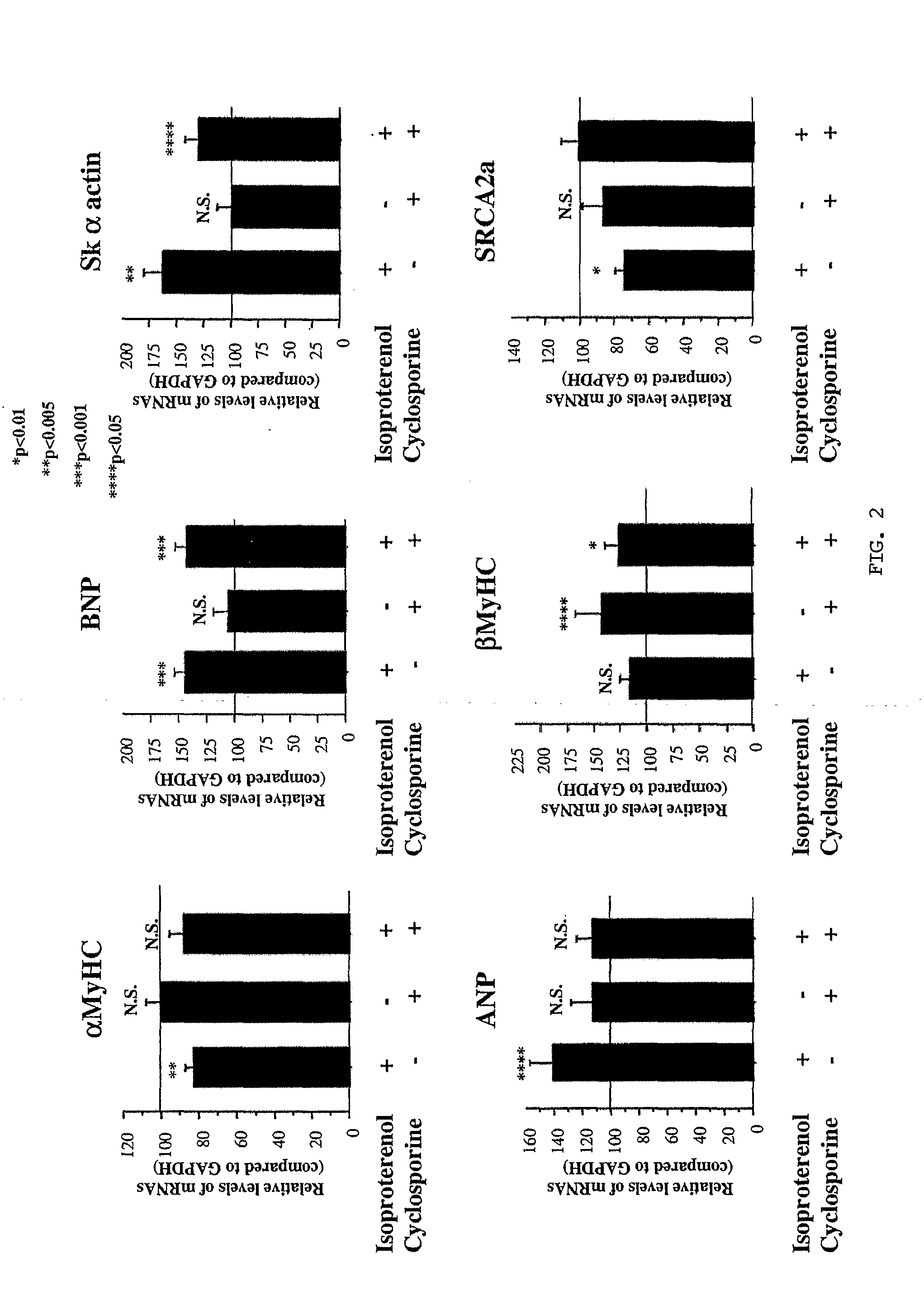Inhibition of extracellular signal-regulated kinase 1/2 as a treatment for cardiac hypertrophy and heart failure
a technology of extracellular signal-regulated kinase and cardiac hypertrophy, which is applied in the field of development biology and molecular biology, can solve the problems of increased heart rate and contractility, failure of heart, and not all patients respond, and achieves increased exercise capacity, decreased left ventricular end diastolic pressure, and increased cardiac ejection volume.
- Summary
- Abstract
- Description
- Claims
- Application Information
AI Technical Summary
Benefits of technology
Problems solved by technology
Method used
Image
Examples
example 1
Materials and Methods
[0312]Materials. Isoproterenol (Sigma) was dissolved in sterile H2O containing 1 mmol / L Ascorbic Acid, and the concentrations used are described in the results section. Additional reagents were added to the cells with the following final concentrations: 2 μmmol / L KN-93 (Sigma), 0.8 μmol / L 14-22 Amide myristoylated (Calbiochem), 1 μmol / L Nicarpidine HCl (Sigma), 30 μmol / L 2-APB (Cayman Chemicals), 1 μmol / L cyclosporine A (Sigma), 10 μmol / L U0126 (Promega).
[0313]Cell Culture. Neonatal rat cardiac ventricular myocytes (NRVMs) were cultured as previously described (Simpson et al., 1982; Simpson and Savion, 1982; Long et al., 1992; Waspe et al., 1990). Briefly, cells were isolated by trypsin digestion from the ventricles of 1-3 day old rats. Isolation procedures were done in a very gentle manner and cells were plated at a concentration of 1.5×105 cells per well in 12-well tissue culture plates in medium containing serum. 24 hours later the media was changed to serum ...
example 2
Results
[0316]Role of CaMK in isoproteremol mediated changes in promoter activity and mRNA expression. CaMK has been implicated in the regulation of the hypertrophic markers skeletal α-actin, BNP, ANP and β-MyHC (reviewed in Zhang et al., 2004). To determine if CaMKII plays a role in the changes in gene expression mediated by β1-AR in NRVMs, cells were pre-treated with the CaMIII inhibitor KN-93. Inhibition of CaMIII by KN-93 prevented isoproterenol-induced changes in endogenous mRNA fetal gene program induction (FIG. 1). More specifically, KN-93 pre-treatment prevented isoproterenol-associated down-regulation of α-MyHC or up-regulation of skeletal α-actin and natriuretic peptides. However, inhibition of CaMK was not capable of preventing repression of SRCA2a, suggesting that SRCA2a gene repression is regulated by a different pathway. Surprisingly, KN-93 alone resulted in a decrease in ANP, β-MyHC, and SRCA2a mRNA levels.
[0317]Inhibition of calcineurin blocks isoproterenol-mediated r...
example 3
Materials and Methods
[0321]Cell Culture, Transfection and Infection: Neonatal rat cardiac myocytes (NRVMs) were prepared according to the method described in Waspe et al. (1990). Briefly, 2,000,000 cells were plated in 100 mm tissue culture plates coated with gelatin. Eighteen hours later, the media was changed to MEM supplemented with Hank's salt and L-glutamine, 20 mM Hepes pH 7.5, Penicillin, Vitamin B12, BSA, insulin and transferin. Cells were infected with an adenovirus expressing YY1-GFP and / or HDAC5-Flag or with a control adenovirus at a MOI of 7 pfu / cell.
[0322]RNase Protection Assay: Total RNA was extracted by TRIZol (Invitrogen) and used in RNase protection assays (RPA). RPAs were performed essentially as described (Patten et al., 1996; Kinuguwa et al., 2001). Briefly, 5 μg of total RNA was hybridized against probes specific to skeletal α-actin, SRCA2A, α-MyHC, β-MyHC, ANF, BNP and GAPDH. RNase protection experiments (RPAs) were performed using the RPAII kit (Ambion). RPA e...
PUM
| Property | Measurement | Unit |
|---|---|---|
| time | aaaaa | aaaaa |
| time | aaaaa | aaaaa |
| delay time | aaaaa | aaaaa |
Abstract
Description
Claims
Application Information
 Login to View More
Login to View More - R&D
- Intellectual Property
- Life Sciences
- Materials
- Tech Scout
- Unparalleled Data Quality
- Higher Quality Content
- 60% Fewer Hallucinations
Browse by: Latest US Patents, China's latest patents, Technical Efficacy Thesaurus, Application Domain, Technology Topic, Popular Technical Reports.
© 2025 PatSnap. All rights reserved.Legal|Privacy policy|Modern Slavery Act Transparency Statement|Sitemap|About US| Contact US: help@patsnap.com



